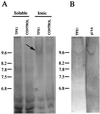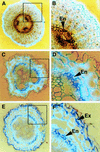A tomato peroxidase involved in the synthesis of lignin and suberin
- PMID: 10759507
- PMCID: PMC58946
- DOI: 10.1104/pp.122.4.1119
A tomato peroxidase involved in the synthesis of lignin and suberin
Abstract
The last step in the synthesis of lignin and suberin has been proposed to be catalyzed by peroxidases, although other proteins may also be involved. To determine which peroxidases are involved in the synthesis of lignin and suberin, five peroxidases from tomato (Lycopersicon esculentum) roots, representing the majority of the peroxidase activity in this organ, have been partially purified and characterized kinetically. The purified peroxidases with isoelectric point (pI) values of 3.6 and 9.6 showed the highest catalytic efficiency when the substrate used was syringaldazine, an analog of lignin monomer. Using a combination of transgenic expression and antibody recognition, we now show that the peroxidase pI 9.6 is probably encoded by TPX1, a tomato peroxidase gene we have previously isolated. In situ RNA hybridization revealed that TPX1 expression is restricted to cells undergoing synthesis of lignin and suberin. Salt stress has been reported to induce the synthesis of lignin and/or suberin. This stress applied to tomato caused changes in the expression pattern of TPX1 and induced the TPX1 protein. We propose that the TPX1 product is involved in the synthesis of lignin and suberin.
Figures





References
-
- Amaya I, Botella MA, Calle M, Medina MI, Heredia A, Bressan RA, Hasegawa PM, Quesada MA, Valpuesta V. Improved germination under osmotic stress or tobacco plants overexpressing a cell wall peroxidase. FEBS Lett. 1999;457:80–84. - PubMed
-
- Bernards MA, Lewis NG. The macromolecular aromatic domain in suberized tissue: a changing paradigm. Phytochemistry. 1998;47:915–933. - PubMed
-
- Bohnert HJ, Sheveleva E. Plant stress adaptations: making metabolism move. Curr Opin Plant Biol. 1998;1:267–274. - PubMed
-
- Botella MA, Quesada MA, Kononowicz AK, Bressan RA, Pliego F, Hasegawa PM, Valpuesta V. Characterization and in situ localization of a salt-induced tomato peroxidase mRNA. Plant Mol Biol. 1994a;25:105–114. - PubMed
Publication types
MeSH terms
Substances
LinkOut - more resources
Full Text Sources
Other Literature Sources
Research Materials
Miscellaneous

